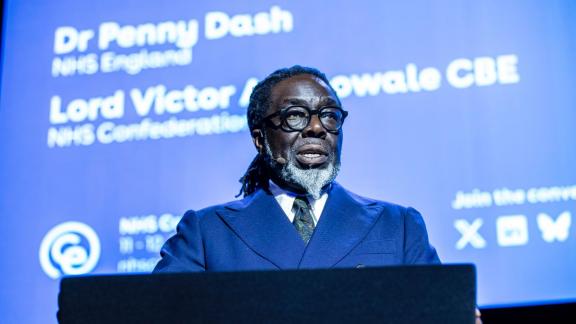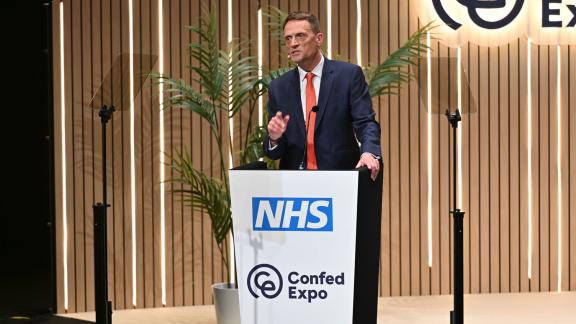Spending Review 2025: what you need to know
Key points
This Spending Review (SR) sets out departmental budgets for 2026/27 to 2028/29 using a spending ‘envelope’ already largely outlined in the Spring Budget.
The Department of Health and Social Care’s budget will increase by an average of 2.8 per cent in real terms over the course of the SR. This largely reflects increases in the revenue side, as the capital budgets have stayed largely as was outlined in the ‘phase one’ Autumn Budget.
The government has made the following health-related announcements, some of which had been made previously:
Up to £10 billion in NHS technology and digital transformation by 202829, an almost 50 per cent increase from 2025-26. This will support digital investment by developing the single patient record, further expansion of the NHS App and continued adoption of the Federated Data Platform.
Additional funding by 2028-29 to train more GPs (although a specific funding figure is not provided).
Allocation of funding for 700,000 additional urgent NHS dentist appointments per year over the Spending Review.
A commitment to expanding mental health support teams to all schools in England by 2029-30 and employing 8,500 additional mental health staff by the end of the parliament.
The 2.8 per cent increase to the DHSC budget over the course of the Spending Review period is generous compared to other departmental budgets in a difficult fiscal environment. However, the announcement falls short of the historic 3.6 per cent increase, and short of the Health Foundation’s 4 per cent target we called for to restore services over the coming decade.
NHS leaders are clear that capital investment is essential to deliver reform and get better value for money from NHS revenue spend. However, capital budgets have remained largely the same as announced in the autumn phase one. [Update: after the publication of the Spending Review, NHS England outlined plans to introduce an off-balance-sheet capital investment model. We strongly support these moves and look forward to working with NHS England and the government to develop these model(s).]
To release the required savings in 25/26 and meet government targets, ICB leaders urgently need clarity on how redundancy costs will be paid for so they can make the decisions for their staff and organisations.
NHS leaders will welcome the government’s commitment to funding across the board to help tackle the social determinants of health – including an additional £3.5 billion for employment support, over £39 billion for a new Affordable Homes Programme and an additional £1.2 billion for skills.

[This briefing was updated on 12 June to include new information about plans to introduce an off-balance-sheet capital investment model, outlined after the publication of the Spending Review.]
Overview
This Spending Review (SR) sets out departmental budgets for 2026/27 to 2028/29 using a spending ‘envelope’ already largely outlined in the Spring Budget.
Total Departmental Expenditure Limits (DEL)
| £ billion (current prices) | Outturn 2023-24 | Plans 2024-25 | Plans 2025-26 | Plans 2026-27 | Plans 2027-28 | Plans 228-29 | Average annual real growth | |
| 2025-26 to 2028-29 | 2023-24 to 2028-29 | |||||||
| Health and social care | 188.5 | 204.9 | 215.6 | 225 | 234.9 | 246.7 | 2.7% | 2.8% |
Source: HM Treasury Public Spending Statistics, HM Treasury DEL plans
The Department of Health and Social Care’s budget will increase by an average of 2.8 per cent in real terms over the course of the SR. This largely reflects increases in the revenue side, as the capital budgets have stayed largely as was outlined in the ‘phase one’ Autumn Budget.
Resource Departmental Expenditure Limits (DEL) excluding depreciation
| £ billion (current prices) | Outturn 2023-24 | Plans 2024-25 | Plans 2025-26 | Plans 2026-27 | Plans 2027-28 | Plans 228-29 | Average annual real growth | |
| 2025-26 to 2028-29 | 2023-24 to 2028-29 | |||||||
| Health and social care | 177.9 | 193.3 | 202.0 | 211.0 | 221.3 | 232.0 | 2.8% | 2.7% |
| of which: NHS England | 171.0 | 186.8 | 195.6 | 204.9 | 215.4 | 226.1 | 3.0% | 3.0% |
Source: HM Treasury Public Spending Statistics, HM Treasury DEL plans
Capital Departmental Expenditure Limits (DEL)
| £ billion (current prices) | Outturn 2023-24 | Plans 2024-25 | Plans 2025-26 | Plans 2026-27 | Plans 2027-28 | Plans 228-29 | Average annual real growth | |
| 2025-26 to 2028-29 | 2023-24 to 2028-29 | |||||||
| Health and social care | 10.5 | 11.6 | 13.6 | 14.0 | 13.5 | 14.8 | 0.0% | 3.2% |
Source: HM Treasury Public Spending Statistics, HM Treasury DEL plans
Health-related announcements
The government has made the following health-related announcements, some of which had been made previously:
- Up to £10 billion in NHS technology and digital transformation by 202829, an almost 50 per cent increase from 2025-26. This will support digital investment by developing the single patient record, further expansion of the NHS App and continued adoption of the Federated Data Platform.
- Additional funding by 2028-29 to train more GPs (although a specific funding figure is not provided).
- Allocation of funding for 700,000 additional urgent NHS dentist appointments per year over the Spending Review.
- A commitment to expanding mental health support teams to all schools in England by 2029-30 and employing 8,500 additional mental health staff by the end of the parliament.
The government also made the following relevant announcements:
- An increase of over £4 billion of funding available for adult social care in 2028-29, compared to 2025-26. This includes an increase to the NHS’s minimum contribution to adult social care via the Better Care Fund.
- Integrated settlements will be expanded to five further Mayoral Strategic Authorities and local government will receive an additional £3.4 billion of grant funding per year by 2028-29, compared to 2024-25.
- A £100 million investment in community help partnerships to bring together a range of services to better support adults with complex needs.
- £410 million per year by 2028-29 to expand Free School Meals eligibility to all pupils in England with a parent receiving Universal Credit.
- Increasing research and development (R&D) funding to £22.6 billion per year by 2029/30. This includes:
- £500 million for the new R&D Missions Accelerator Programme, which will leverage a further £1.5 billion of private investment into innovation challenges that support the government’s mission.
- £410 million Local Innovation Partnerships Fund, giving local leaders a central role in co-creating R&D programmes to support local economies.
- Over £2 billion to drive the AI Action Plan including a 20-fold increase in support for compute capacity, with £160 million for TechFirst to ensure people have the right skills to deliver technological change.
Analysis
The 2.8 per cent increase to the DHSC budget over the course of the spending review period is generous compared to other departmental budgets in a difficult fiscal environment. However, the announcement falls short of the historic 3.6 paer cent increase, and short of the Health Foundation’s 4 per cent target we called for to restore services over the coming decade. The government’s ambitious Plan for Change target to cut elective waiting times and deliver reform through the three shifts in the forthcoming ten-year health plan will be challenging with this spending commitment. There is a real risk that ongoing political rhetoric about prioritising NHS spending drives increased public expectation that the NHS remains unequipped to meet.
While NHS England’s budget will increase by 3 per cent over the same time frame, the scope of what this covers has expanded and therefore it is no longer a complete picture of what NHS England will be asked to do. The number of things that NHS England is asked to do outside the ring-fenced budget has grown over the years (examples include COVID-19 vaccinations, the Elective Recovery Fund, and, most importantly, Health Education England), so it is difficult compare between years. The DHSC transfers parts of its non-ring-fenced budget that it keeps in reserve to NHS England to do this throughout the year, and so the DHSC overall budget now better represents the total NHS spending direction.
...NHS leaders are clear that capital investment is essential to deliver reform and get better value for money from NHS revenue spend
To deliver reform and hit NHS targets within this funding envelope, NHS leaders will therefore need backing from the government to redesign services and balance budgets. That means getting political backing when some services are redesigned or cut, including moving hospital services into the community and closer to people’s homes as part of the government’s three shifts.
Crucially, NHS leaders are clear that capital investment is essential to deliver reform and get better value for money from NHS revenue spend. However, capital budgets have remained largely the same as announced in the autumn phase one. It is unclear how this sits with the government’s commitment to transfer services to the community, fix the £14 billion maintenance backlog, or the remainder of the New Hospital Programme. That is before addressing the £37 billion historical shortfall in NHS capital investment over the last decade identified by the Darzi Review.
The NHS Confederation estimates that an additional £3.3 billion in capital investment was needed each year of the three-year Spending Review period to help address the maintenance backlog and to uplift NHS productivity growth to 2 per cent per year. We have also been calling for loosened rules for private investment to develop new public private partnership models, that crowd in public investment and learn the lessons from previous private finance models, to help make up some of the funding.
Update
Late on 11 June after the publication of the Spending Review, NHS England outlined plans to introduce an off-balance-sheet capital investment model – with little information other than a single line setting out their intent. We strongly support these moves, and look forward to working with NHS England and the government to develop these model(s).
With no uplift in capital spending forthcoming from the Treasury in this Spending Review, it is essential that the government uses its ten-year infrastructure strategy, expected imminently, to open new routes for private investment to make up the shortfall.
An important increase in investment in digital transformation, technology adoption and AI is positive and will be necessary to achieve ambitions for the NHS App being the digital front door and to develop and deliver a single patient record. The challenge will be deploying this funding effectively in the context of NHS reorganisation and a drive to achieve financial savings.
As ICBs look to reduce their operating costs by 50 per cent, there is continued uncertainty on funding available nationally to cover the cost of redundancies in ICBs and providers. To release the required savings in 25/26 and meet government targets, ICB leaders urgently need clarity on how redundancy costs will be paid for so they can make the decisions for their staff and organisations.
NHS leaders know from bitter experience that protecting health funding while cutting other areas ends up costing more in the long run
Outside of NHS spending, NHS leaders know from bitter experience that protecting health funding while cutting other areas ends up costing more in the long run. Studies have shown that 80 per cent of our health is shaped by factors such as education, employment and housing. However, in recent years, real-terms cuts to local government funding for public health, social care and housing investment have pushed up demand for healthcare and worsened NHS finances and waiting times. Shifting from sickness to prevention requires partnership working across local government and other government departments nationally.
NHS leaders will therefore welcome the government’s commitment to funding across the board to help tackle the social determinants of health – including an additional £3.5 billion for employment support, over £39 billion for a new Affordable Homes Programme and an additional £1.2 billion for skills. The expansion of integrated settlement to more Mayoral Strategic Authorities areas in England will allow for a more holistic, joined-up and localised approach to improve outcomes. NHS leaders will need to continue to engage with local partners as powers and responsibilities are increasingly devolved across more regions.
WorkWell, the Get Britain Working trailblazers and the Health and Growth Accelerators are demonstrating how the NHS, local government, and wider partners can collaborate to support people in living healthier working lives. It is therefore welcome that the government has commitment led to increase funding for employment support to over £3.5 billion by 2028–29, and to extend the Inactivity and Youth Guarantee Trailblazers announced in the Getting Britain Working white paper. Good work is good for health, and improving access to quality employment is essential to enhancing the health and prosperity of all communities.
NHS leaders will also welcome the government’s commitments to expand mental health support teams in schools. However, with mental health trusts expected to make up to seven per cent cost reductions this year, expanding these services will be very challenging for our members, and likely to the determent of other mental health services. The additional 8,500 mental health workforce over the course of the parliament is far below the level of expansion over the past five years and the commitments in the Long Term Workforce Plan, and we have urged the government to be more ambitious in its workforce expansion targets.
As frequently pointed out by the likes of the Institute for Fiscal Studies, governments have rarely kept to their Spending Review plans for the duration of the review. If this historical trend continues, we can expect this government to do the same. This is largely because events get in the way of even the best laid plans. For example, the previous long-term Spending Review in 2021 had planned NHS pay rises of about 2 per cent per year for three years, in line with inflationary expectations from the previous decade. The eventual inflationary spike after Covid-19 and the Russia-Ukraine conflict meant HM Treasury had to frequently top up the DHSC’s budget to account for higher pay increases.
Interestingly, productivity documents published alongside by HM Treasury as part of the Spending Review outline that the government assumes, leads to £8.95 billion of annual efficiencies by 2028-29 as part of its 2 per cent annual productivity increase over the coming decade. This is more than double the rate for the previous 25 years.
Political context
Ahead of the Spending Review, the government had briefed to the media that the Prime Minister will ‘stake his political fortunes on the NHS’, increasing health spending by 2.8 per cent in real terms annually over the three-year Spending Review period to achieve the Plan for Change target to hit the 92 per cent elective care waiting standard by the end of the parliament. Explicitly, the government communications operation has made it clear that this 'boost' comes at the expense of other public services. However, cuts to local council budgets and to other public services shape the social determinants of health which drive up demand for healthcare and increase pressure on NHS budgets. So health leaders will welcome the increased funding for crucial areas including employment support, housing and skills, as key drivers of health outcomes.
With the government’s commitment to devolution, the expansion of integrated settlements marks a decisive step towards greater responsibility and autonomy being given to directly elected mayors. While questions remain as to the statutory health duty of mayors, we hope it will encourage and enable further local join-up of public services.
Headlines ahead of the Spending Review have focused on the government's policy change in relation to winter fuel allowance - extending entitlement to more than 75 per cent of pensioners in England and Wales. Pensioners with an income of £35,000 or less will receive the payment automatically this winter. Pensions and welfare issues sit outside of the Spending Review process, so full details will be published at an anticipated Autumn Budget. The Chancellor and party leadership had come under much criticism - including from their own MPs - since the decision to means test the allowance was introduced in October 2024. It's been speculated that the change in policy has been announced ahead of the Spending Review to avoid the ongoing concern overshadowing the most important fiscal event since the government's election last July.
It has also been reported that there have been several disputes between the Chancellor and other Cabinet ministers who are deeply concerned about what they are facing over the next three years in their departments. This is not unusual ahead of a Spending Review. But such commentary about inter-Cabinet resentment is likely to continue, especially if the NHS is not considered to be delivering.
This anticipated increase in revenue spending will also come in the context of ICBs being expected to reduce budgets by 50 per cent, and cuts to corporate budgets for NHS trusts. We know our members are deeply concerned about what these cuts mean for their ability to deliver on government NHS reform.
How we are supporting members
Our strategic policy team leads our work on NHS finance and are currently working towards a new report setting out what a new series of public-private partnerships should look like. We welcome members’ input: please contact Jonathan.barron@nhsconfed.org.
Through our System Productivity Forum, we are convening members across all sectors and roles to learn from each other, share best practice and influencing policymaking on productivity.
Our dedicated Health Economic Partnerships team looks forward to continuing its support for local areas as we transition to a more integrated neighbourhood approach of supporting people to live healthier and more prosperous lives.



